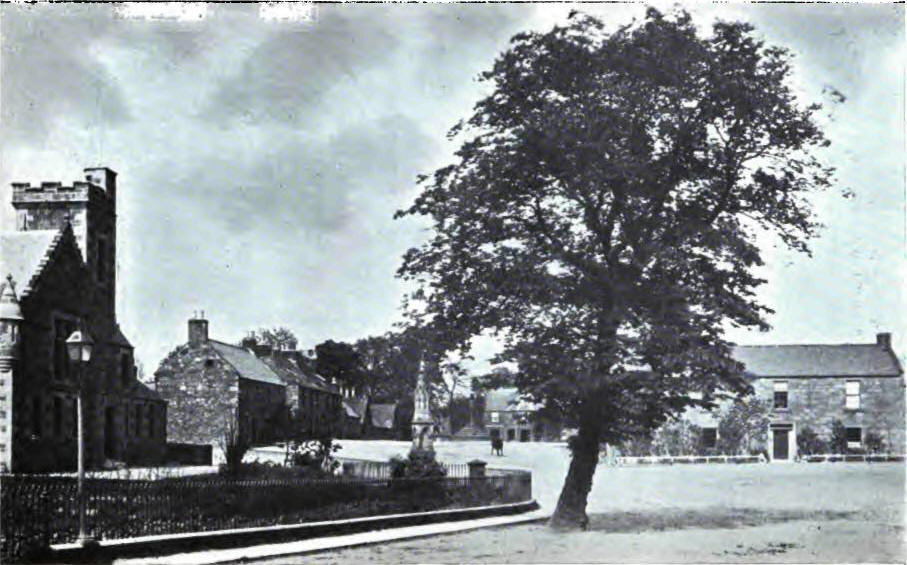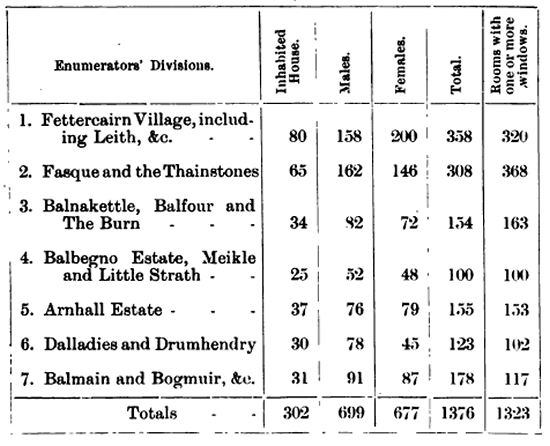OF the population, the first
authentic account was given by Dr Webster in 1755, who made it 1950 souls;
but according to Mr Garden's statement it was in 1774 only 1500. In the old
statistical account of the parish by the Rev. Robert Foote, he states it as
2000 in 1791. By the first Government census in 1801 it was 1794, and by the
next, in 1811, it was only 1562. Hence it appears that in the twenty years
from 1791 to 1811 a great decrease of population took place, viz., from 2000
to 1562. The first two or three years of the century were years of dearth;
food and provisions were at a ransom. Oatmeal was sold at 4s. a peck, or
64s. per boll. Many of the people were reduced to beggary, and scores of
poor people were relieved by the Kirk Session. Those dear times no doubt
tended to reduce the population, which however must have been abnormally
high in the earlier years of the period, when Lord Adam Gordon employed a
large number of workmen on The Burn estate at the building of The Burn
House, the trenching of the surrounding moorland, the planting of his woods,
the formation of roads, and of the beautiful walks along the rocky banks of
the river. The following table shows the total population of the parish, and
the number residing in the village, according to the census returns from
1821 to 1891 inclusive:—


From the foregoing, it may be
noticed that in the fourth •decade of the century there is a marked and
irregular increase •of 157 in the population, raising the total to what it
was in 1801. To account for this increase, only one cause can be assigned,
viz., that during these years, on the •estate and policies of Fasque,
extensive improvements, the formation of the lake and other important works,
giving employment to many additional labourers, were carried on by the late
Sir John Gladstone upon his newly .acquired property. Sir John had made
Fasque his principal family residence, and a large accession of servants
.and employees increased the population.
In the Balfour and Newdosk
section, now disjoined from Edzell and annexed to Fettercairn, the census of
1801 gave 107 souls, and in 1891 only 45; which, if added to the above 1376,
makes the total population 1421. In the above enumerations of the village,
Leith, West Burnside, and the Free Church manse are included. At this date
(1899) there remain of the 1741 people in 1851 only about 4 males and 7
females in the village; and about 17 males and 19 females in the country
district of the parish. •Of every 100 persons in 1801, 46 were males and 54
females; in 1831, 47 were males and 53 females; and much the same
proportions appear to hold till 1861, when the males were to the females as
48 to 52; in 1871, 48.5 to 51.5; in 1881, 49.1 to 50.9; and in 1891, 50.75
to 49.25. These figures indicate a steady increase of males and a
corresponding decrease of females, which may be accounted for by the gradual
change that has taken place in the conditions of agricultural employment.
Owing to the introduction of improved machinery and implements for farm
work, fewer women are now employed. In former times women for outdoor work
were hired at the half-yearly term markets; but now the market hiring of
women has ceased and they are engaged only for domestic service, either near
home or in the neighbouring towns ; while not a few have gone to work in
mills and manufactories. If the relative numbers of males and females in the
village, with the 21 males and 27 females in the hamlet of Old Mains at last
census, be omitted from the above calculations, it will be found that in the
rural parts of the parish the percentage of males to females is as 53*6 to
464. And it may be taken for granted that the same changes are taking place
in other rural parishes. For the forty years (1855-95) -during which the
writer was Registrar, the highest number of births in a year was 62 and the
lowest 37; of deaths, 37 and 10; and of marriages, 16 and 5.
The following table contains
a summary of statistics brought out by the census of the parish (excluding
Newdosk) in 1891, which may be of use to future Registrars and enumerators
:—

The most striking fact in the
foregoing table is that in the Dalladies and Drumhendry division, a purely
farming district, the males are 78 and the females 45—a fact which proves so
far that females, as above stated, are less and less required for farm
labour.
Mr Foote, in his Statistical
Account (written a hundred years ago), gives the numbers employed in certain
trades, and these are presumed to include journeymen and apprentices as well
as masters, and are as follows:— Handloom weavers, 50; shoemakers, 25;
tailors, 16; wrights, 18; blacksmiths, 10; and millers, 10. There are now no
handloom weavers: John Caithness, who died a few years ago, was the last;
the shoemakers are only three or four; the tailors also three or four; the
blacksmiths have not decreased; and the millers are only one-half the former
number. Mr Foote states the number of tenant farmers as 170; the number now
is about 60, of whom at least seven are tradesmen with crofts or small
holdings.
Of the male population
employed as farm servants, about 105 are householders, and from 15 to 20 are
young men lodged for the most part in farm bothies. The number of male heads
of households in other callings and trades is about 115. The manufactures in
the parish are few and not very important. The largest is that of
Fettercairn Distillery at Nethermill, which employs ten or twelve men. It
was founded in 1824 by a company, with the late James Durie as manager, who,
after a time, acquired the concern, and carried it on successfully till his
death in 1854. His son David succeeded, and extended the business till
October, 1889, when the premises were destroyed by fire. From its well-known
quality the genuine "Fettercairn" commanded the highest price in the home
and foreign markets. In 1891 a joint-stock company renewed the buildings,
fitting them with machinery and apparatus capable of greatly increased
production.
For thirty years previous to
1875 a successful pork-curing business was carried on by the late James
Dakers, and since then, with the exception of a small woollen factory at
Arnhall and a freestone quarry at Caldcotes on the estate of Fasque, the
chief sources of employment are to be found in agricultural pursuits. In
former times the parish contained five or six inns or ale-houses, of which
the Ramsay Arms Hotel, the Forbes Arms Hotel, and the Red Lion Inn were in
the village. The only one now remaining is the Ramsay Arms, owned and
enlarged by the Edzell Hotel Company.

